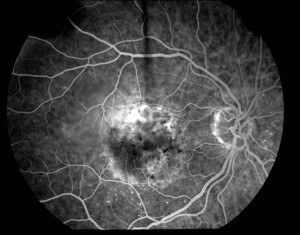Age-Related Macular Degeneration
Age-Related Macular Degeneration (AMD) is a progressive eye condition affecting as many as 15 million Americans and millions more around the world. The disease attacks the macula of the eye, where our sharpest central vision occurs. This is the vision we use to drive, read, recognize faces and perform daily tasks. AMD does not cause complete blindness, only central blindness. It spares the peripheral vision (around the edges), leaving only dim images or black holes at the center of vision.
Symptoms include: A dark area in the center of vision, blurred or wavy vision and/or distortion
AMD is the number one cause of severe vision loss and legal blindness in adults over 60 in the U.S. It escalates with age. It affects 14%-24% of the U.S. population aged 65-74 years and 35 – 40% of people aged 74 years or more have the disease. In other words, more than one person in three can develop signs of age-related macular degeneration, with over 200,000 new cases diagnosed every year.
There are two types of AMD – “wet” or neovascular and “dry” or atrophic. There is no cure for AMD, but, a variety of therapies are available for wet macular degeneration, with intravitreal injections the standard of care.There is no treatment for the dry form of macular degeneration …yet. The good news is Pepose Vision is at the forefront in exciting new clinical research studies and offers an opportunity for our patients to benefit from these studies. Please see below to learn more about our AMD studies and how you could possibly participate.
Even with vision loss, training and special devices can promote independence and a return to favorite activities.

The human retina is made up of layers of cells that line the entire inside of the globe of the eye.The macula is the most sensitive part of the retina, located in the very center of the retina. When light strikes the back of the eye, the cells of the macula and the rest of the retina send electrical signals to the brain through the optic nerve which leads to the brain. The brain translates the electrical signals into the images we see. It is about the size of the head of a straight pin and contains millions of light-sensing cells that provide sharp, detailed central vision. If the macula is damaged, the images received by the brain are distorted or not clear.
How do I know if I have Age-Related Macular Degeneration?

Many people do not realize they have a macular problem until they notice they have blurred or distorted vision. Regular eye exams by an ophthalmologist may help to detect problems or early stages of macular degeneration before you are even aware of them.
Dry macular degeneration: Detection with an ophthalmoscope
To check for macular degeneration, we will dilate (widen) your pupils using eyedrops and examine your eyes with an ophthalmoscope, a device that allows us to see your retina and other areas at the back of your eye. If macular degeneration is detected, we may have you use an Amsler grid to check for macular degeneration symptoms such as wavy, blurry or dark areas in your vision.Wet macular degeneration:
Detection with fluorescein angiography and optical coherence tomography
If we suspect you may have the wet form of macular degeneration, we will take special photographs of your eye with fluorescein angiography and optical coherence tomography (OCT). OCT scanning is a sophisticated and exact tool that detects abnormal blood vessels by creating a special picture of your macula.
During fluorescein angiography, a fluorescein dye is injected into a vein in your arm. The dye travels throughout the body, including your eyes. Photographs are taken of your eye as the dye passes through the retinal blood vessels. Abnormal areas will be highlighted by the dye, showing us whether wet macular degeneration treatment is possible and, if so, where to treat the abnormal vessels.
The Macular Disease Society Has Published This Helpful Video Entitled “Living With Macular Degeneration”
Frequently asked questions
Exciting Age-Related Macular Degeneration Clinical Studies at Pepose Vision.
This is an excellent opportunity to try tomorrow’s technology today.
In addition to a wide range of advanced vision services, Pepose Vision Institute is also a ophthalmological research center. We perform important clinical studies on new treatments for a variety of vision issues. Some of our most exciting studies are for the treatment of the dry form of Macular Degeneration. This is exciting because at present there are no known treatments.
Our studies offer our patients a chance to experience the latest breakthroughs in the treatment of dry form of Macular Degeneration. And to play an important role in helping to potentially develop treatments for millions of people that experience this condition.
To learn more about our studies, please click here.
What’s your next step?
If you have any of the symptoms we’ve discussed on this page, or you’ve been diagnosed by your eye doctor with macular degeneration, please come see us right away. Our experienced doctors will use advanced diagnostics to determine exactly how to help you see your very best, patiently answer your questions and carefully explain all your options, including our clinical studies.

